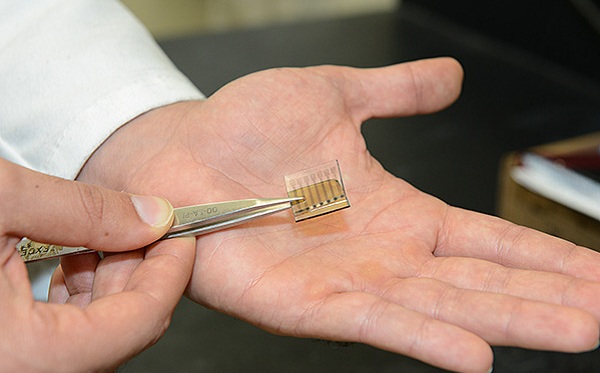In what they say could be a step toward dramatically less expensive solar power, Stanford University researchers are reporting they’ve developed a solar cell made entirely out of carbon.
Now they just need to improve on its efficiency, which comes in at less than 1 percent, a small fraction of typical cells that deliver in the teens to 20 percent or more.

Solar cells are most commonly made from silicon, which has been declining in price, and that’s been one factor in the falling cost of solar power systems. Still, the Stanford researchers say their thin-film prototype – made of carbon materials that can be coated from solution – has the potential to take a slice out of the tab for the current multistep solar manufacturing process.
“Processing silicon-based solar cells requires a lot of steps,” Stanford graduate student Michael Vosgueritchian, co-lead author of a paper on the technique with postdoctoral researcher Marc Ramuz, said in a statement. “But our entire device can be built using simple coating methods that don’t require expensive tools and machines.”
Zhenan Bao, a professor of chemical engineering at Stanford, was the study’s senior author.
“Carbon has the potential to deliver high performance at a low cost,” she said. “To the best of our knowledge, this is the first demonstration of a working solar cell that has all of the components made of carbon.”
While the Stanford press release on the breakthrough contrasted the carbon cell with silicon cells, it also drew a perhaps more apt comparison with other thin-film cells, noting that the electrodes in the typical thin-film cell are made of conductive metals and indium tin oxide (ITO).
“Materials like indium are scarce and becoming more expensive as the demand for solar cells, touchscreen panels and other electronic devices grows,” Bao said. “Carbon, on the other hand, is low cost and Earth-abundant.”
The incredibly thin material graphene was used with carbon nanotubes said to be 10,000 times narrower than a human hair for the active layer of the cell.
“Every component in our solar cell, from top to bottom, is made of carbon materials,” Vosgueritchian said. “Other groups have reported making all-carbon solar cells, but they were referring to just the active layer in the middle, not the electrodes.”
On the question of efficiency, the researchers said that “with better materials and better processing techniques, we expect that the efficiency will go up quite dramatically,” but they added that “the ability of carbon solar cells to out-perform conventional devices under extreme conditions could overcome the need for greater efficiency.”